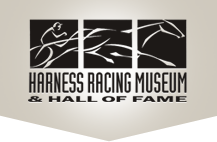
george francis schreiber
In the formative years of the Standardbred breed, George Francis Schreiber presented the trotting community with one of its most precious gifts: an authentic image of many of its founding sires and dams, including Hambletonian, Goldsmith Maid, Ethan Allen, American Girl, Green Mountain Maid and Flora Temple. Traditionally the responsibility of painters and illustrators, in many cases portraits tended to sacrifice precision and accuracy in order to appease the owner’s vanity. The result was a lovely, often fanciful, picture of a horse; but not one that could always be trusted. Schreiber amended this characteristic of portraits by focusing on their potential long-term function rather than their short-term enjoyment. In his book, Portraits of Noted Horses of America, Schreiber states: “The value of such pictures as these is not alone in the pleasure of the present, but will increase with years, indefinitely, becoming an interesting part of history that can forever be relied on as perfectly accurate.” If not for Schreiber’s skill as a photographer and forward-thinking mindset, later generations, including key artists Robert Dickey and George Ford Morris, would only have subjective paintings as references and no record at all of those horses whose portraits were never commissioned, such as Mambrino Patchen, Americus and Sentinel.
George Francis Schreiber was the first professional photographer to focus his business on the portraits of race horses, an idea that strayed from the normal repertoire of fellow photographers and caused contemporary artists to fear for their livelihood. Born on January 10, 1803 in Frankfort-on-Main, Germany, Schreiber entered into the printing trade after receiving an elementary education. As a young man, he worked as a journeyman in Bremen and Hamburg, Germany and St. Petersburg, Russia before moving to America in 1834. With the aid of a fellow countryman, Mr. Schwatka, he established a newspaper, Die Alte und Neue Welt – The Old and New World.
In 1844, after meeting photographer Frederick Langenheim and learning of his camera obscura, Schreiber took a risk by leaving the printing business and devoting himself to the art of photography. The two men began experimenting with daguerreotypes using Schreiber’s children as subjects. When they became confident with their skills, they rented a room in the Philadelphia Exchange. As their popularity grew, Schreiber became increasingly interested in not only the art of photography but also the science. In his spare time he began inventing new cameras and methods for developing images. He is credited with being the first American photographer to use glass as a negative, from which he developed the hyalotype, or crushed glass negative. Another such innovation was a large, sectional camera which allowed him to capture a series of remarkable views of Niagara Falls. The photographs not only won a variety of awards but also inspired Queen Victoria to write him a letter of admiration.
In the 1850s, despite their widespread esteem, Frederick Langenheim unexpectedly withdrew from the partnership. Left to continue the business by himself, Schreiber moved to a new store and continued to work on perfecting his images. One skill he truly excelled at, to the dismay of all his competitors, was the art of toning photographs.
Schreiber did not remain without a partner for long. In the 1860s five of his sons joined him, which resulted in the company name being changed to Schreiber & Sons. Along with their name, their subject base changed as well; their photographs now focused on animals, particularly horses. Schreiber & Sons was the first professional photography business devoted to producing portraits of race horses, a field that had previously been dominated by painters and illustrators. The most prestigious of their subjects was Hambletonian, and the portrait produced by Schreiber & Sons in 1866 is arguably the most faithful representation of the Standardbred foundation sire. Not only was it taken much earlier than other images of Hambletonian, when he was seventeen rather than when he was old and past the prime of life, but it is also the only image of him that has never been retouched by studio painters. Aside from Hambletonian, Schreiber & Sons also photographed horses such as Goldsmith Maid, Ethan Allen, Flora Temple, American Girl, Green Mountain Maid, Lucy and Almont.
Succeeding where their predecessors had failed, Schreiber and his sons used their profound skill and experience to prove to their clients that professional photography was capable of producing more lifelike images than even the most talented artist. In fact, according to historian Alexander Mackay-Smith, renowned equine artist Edward Troye mysteriously stopped painting in 1872 after learning that Schreiber & Sons was publishing a portfolio of noted horses the following year. While other photographers were unable to accurately portray the graceful mystique inherent in the Standardbred, Schreiber & Sons was able to invoke these qualities and win the respect of the trotting community. An article which appeared in the October 1875 issue of Wallace’s Monthly states: “By the indefatigable and long continued efforts and experiments of Messrs. Schreiber & Sons, of Philadelphia, the principal difficulties [of photography] have been overcome, and by their own appliances they have demonstrated their ability to make not only truthful, but elegant pictures.”
Schreiber passed away in 1892 at the age of eighty-nine. A healthy man for his age, he was weakened beyond recovery by an unfortunate case of la grippe followed by bronchitis. He was survived by his eight children and his significant impact on the field of photography and the world of trotting.

